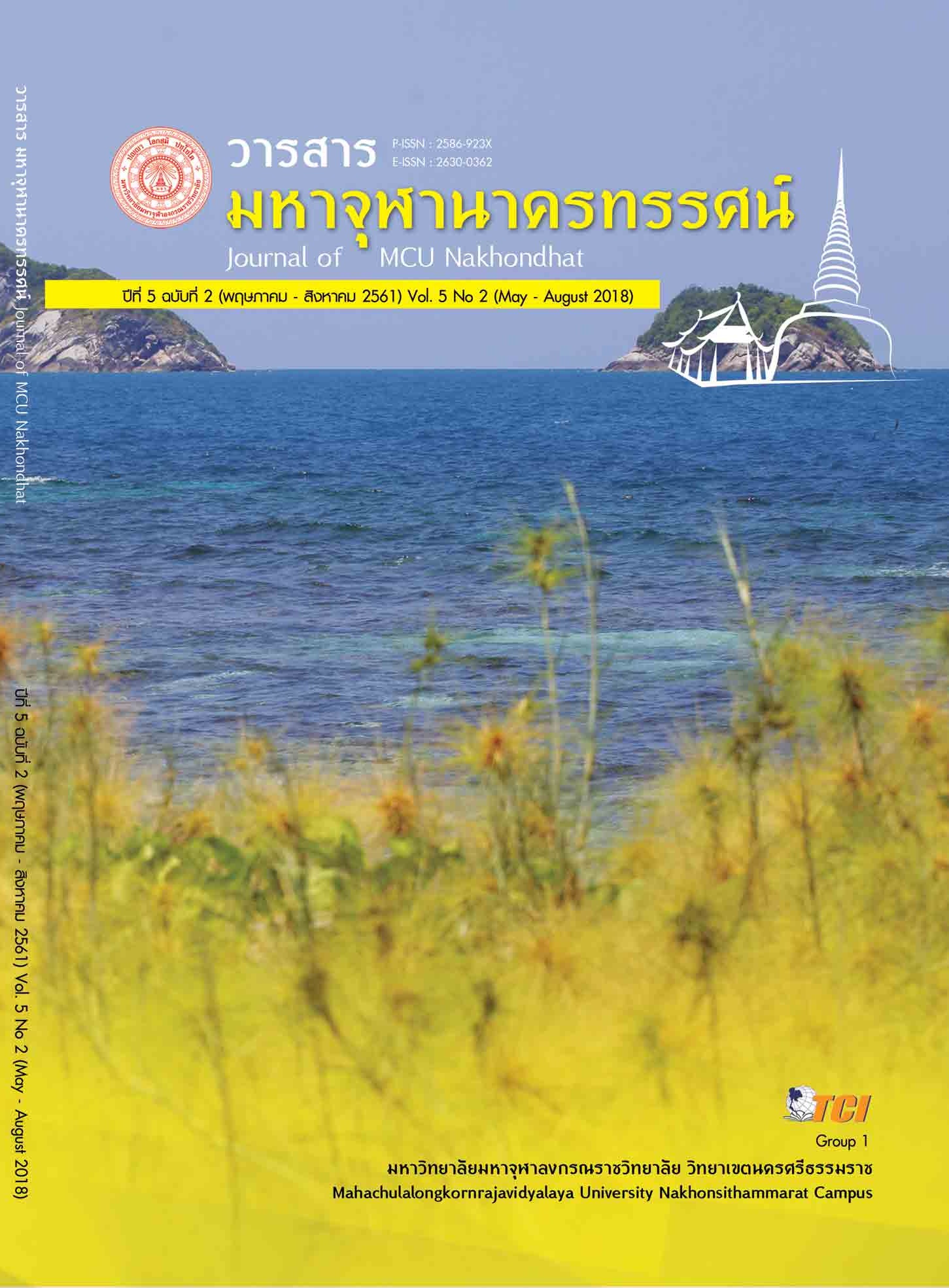Solving the Problem of Chronic stress through the Buddhist philosophy on Four Foundations of Mindfulness
Main Article Content
Abstract
The objectives of this Research are as follows: 1) to study the causes of Chronic stress and affect to people and society; 2) to study the Buddhist philosophy of Four Foundations of Mindfulness; 4) To apply the principles and methods of mindfulness in Buddhist philosophy and solve the problem of Chronic stress more effectively. 4) To create new knowledge and patterns of healing by the Buddhist principles. Metrology is a document that focuses on qualitative research.
The results of research were found as follows:
- The cause of stress is caused by several factors such as poverty. Problems at work, Family problems, Love problems, Learning problems, Unemployment problems, anxiety problems, Problems of irritability, problems of craving, conceit, problems of anger, the problem is overwhelmed by worldly conditions. Life failure problem. These problems cause stress.
- The principle of Buddhist philosophy in terms of healing is to balance the body and mind, that is to follow the middle way, focus on the body and mind, which is in accordance with the Four Foundations of Mindfulness, which teaches the practice of the body called contemplation of the body (Kayanupassana), to practice of the emotion called contemplation of feelings (Vedananupatsana), to practice of the mind called contemplation of mind (Cittanupatsana), to practice of the thing occurs or the truth appears called Dhammanupatsana.
- The Principle and Method of Mindfulness in Buddhist Philosophy and Problem Solving in Stress, it makes the researcher understands the principles of mindfulness practice. It can be used in a variety of ways such as walking, determining the breath in-breath out, Counting, the development of meditation, focus on meditation devices, the development of insight meditation. These methods are used to practice meditation.
- New knowledge and patterns of disease healing by Buddhist Philosophy get the patterns leads to the development of Four Foundations of Mindfulness as follows: 1) the principle of faith, the practitioner must have belief in the faith of the Four Foundations of Mindfulness that can cure stress. 2) The principle of effort or perseverance must be practiced with perseverance in earnest. 3. The principle of wisdom is the knowledge around the subject, such as practice the mindfulness of breathing (Anapanasati). And know how to determine the breath in – breath out as prescribed.
Article Details
How to Cite
จนฺทสโร (กาญจนแก้ว) พ. (2018). Solving the Problem of Chronic stress through the Buddhist philosophy on Four Foundations of Mindfulness. Journal of MCU Nakhondhat, 5(2), 377–393. retrieved from https://so03.tci-thaijo.org/index.php/JMND/article/view/137793
Section
Research Articles
References
จรัสแสง ผิวอ่อน. (2554). การจัดการเพื่อดูแลผู้ป่วยมะเร็งระยะสุดท้ายแบบองค์รวม.
พระเทพวิสุทธิกวี (พิจิตร ฐิตวณฺโณ). (2549). การบริหารจิต. กรุงเทพมหานคร: เซเวนกรุ๊ฟ จำกัด.
พระธรรมปิฎก (ป.อ.ปยุตฺโต). (2540). พจนานุกรมพุทธศาสน์ ฉบับประมวลศัพท์ . กรุงเทพมหานคร: : โรงพิมพ์มหาจุฬาลงกรณราชวิทยาลัย.
พระพรหมโมลี (วิลาศ ญาณวโร,ป.ธ.9). ( 2545). โลกทีปนี. กรุงเทพมหานคร: สำนักพิมพ์ดอกหญ้า .
พระพลกฤษณ์ โชติศิริรัตน์. (2554). การศึกษาเชิงวิเคราะห์การรักษาโรคด้วยวิปัสสนากัมมัฏฐานตามแนวทางของพระธรรมสิงหบุราจารย์. ใน มหาวิทยาลัยมหาจุฬาลงกรณราชวิทยาลัย (บ.ก.).
พระสาโรจน์ ธมฺมสโร (แซ่อู้). (2559). การนำอิทธิบาทธรรมไปใช้ในการเรียนของนักเรียนโรงเรียนพึ่งตนเอง . จังหวัดนครศรีธรรมราช: วารสารมหาจุฬานาครทรรศน์.
มหาวิทยาลัยมหาจุฬาลงกรณราชวิทยาลัย. (2539). ใน พระไตรปิกฎภาษาไทย. กรุงเทพมหานคร.
มหาวิทยาลัยมหาจุฬาลงกรณราชวิทยาลัย. (2539). พระไตรปิฎกภาษาไทย ฉบับมหาจุฬาลงกรณราชวิทยาลัย . กรุงเทพมหานคร: โรงพิมพ์มหาจุฬาลงกรณราชวิทยาลัย.
พระเทพวิสุทธิกวี (พิจิตร ฐิตวณฺโณ). (2549). การบริหารจิต. กรุงเทพมหานคร: เซเวนกรุ๊ฟ จำกัด.
พระธรรมปิฎก (ป.อ.ปยุตฺโต). (2540). พจนานุกรมพุทธศาสน์ ฉบับประมวลศัพท์ . กรุงเทพมหานคร: : โรงพิมพ์มหาจุฬาลงกรณราชวิทยาลัย.
พระพรหมโมลี (วิลาศ ญาณวโร,ป.ธ.9). ( 2545). โลกทีปนี. กรุงเทพมหานคร: สำนักพิมพ์ดอกหญ้า .
พระพลกฤษณ์ โชติศิริรัตน์. (2554). การศึกษาเชิงวิเคราะห์การรักษาโรคด้วยวิปัสสนากัมมัฏฐานตามแนวทางของพระธรรมสิงหบุราจารย์. ใน มหาวิทยาลัยมหาจุฬาลงกรณราชวิทยาลัย (บ.ก.).
พระสาโรจน์ ธมฺมสโร (แซ่อู้). (2559). การนำอิทธิบาทธรรมไปใช้ในการเรียนของนักเรียนโรงเรียนพึ่งตนเอง . จังหวัดนครศรีธรรมราช: วารสารมหาจุฬานาครทรรศน์.
มหาวิทยาลัยมหาจุฬาลงกรณราชวิทยาลัย. (2539). ใน พระไตรปิกฎภาษาไทย. กรุงเทพมหานคร.
มหาวิทยาลัยมหาจุฬาลงกรณราชวิทยาลัย. (2539). พระไตรปิฎกภาษาไทย ฉบับมหาจุฬาลงกรณราชวิทยาลัย . กรุงเทพมหานคร: โรงพิมพ์มหาจุฬาลงกรณราชวิทยาลัย.


